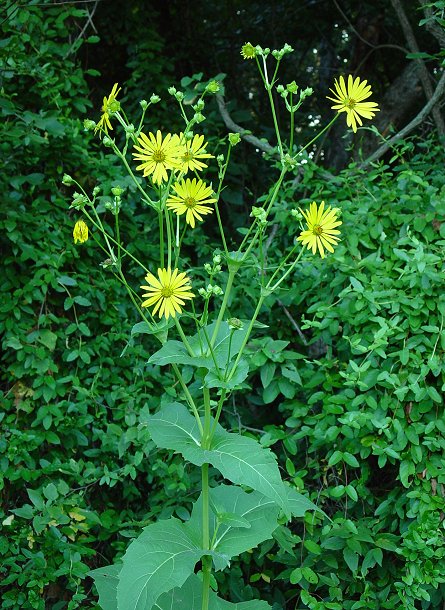Silphium perfoliatum L.
Cup Plant

Native
CC = 3
CW = -3
MOC = 58
© DETenaglia
Silphium perfoliatum L.Cup Plant | |
 |
Native CC = 3 CW = -3 MOC = 58 |
© DETenaglia |
|
Family - Asteraceae/Heliantheae Habit - Rhizomatous perennial forb. Stems - Ascending to erect, to 2.5 m, often multiple, strongly 4-angled in cross-section, glabrous or rarely sparsely pubescent with relatively short (mostly 0.2-0.5 mm), slender hairs toward the base, occasionally slightly glaucous.
Leaves - Opposite, relatively thick but not or only slightly leathery, the upper surface moderately roughened with small pustules and sometimes also with sparse, minute hairs, the undersurface moderately to densely roughened-pubescent with a mixture of short and minute, spreading, mostly pustular-based hairs. Basal and lowermost stem leaves absent or withered at flowering, long-petiolate, the petioles often expanded into a pair of basal auricles, these wrapped around the stem and those of the stem leaves often perfoliate, the blade 10-30 cm long, ovate to triangular-ovate, unlobed, tapered to a usually sharply pointed tip, tapered to angled at the base, the margins otherwise finely to coarsely toothed and with minute appressed hairs. Stem leaves progressively reduced from about the midpoint of the stem, 3-35 cm long, the largest pairs of leaves with short to long, broadly winged petioles, these expanded toward the base and strongly perfoliate, fused into a leafy cup around the stem, or rarely not perfoliate, the median and upper leaves mostly short-petiolate to sessile.
Inflorescences - Loose, open clusters or panicles, the heads long-stalked to short-stalked or nearly sessile. Heads - Involucral bracts 25-38, 12-27 mm long, elliptic to ovate, loosely ascending to somewhat spreading at the bluntly to sharply pointed tip, the outer surface usually glabrous, the margins with minute, ascending hairs. Receptacle 1.5-2.5 cm in diameter.
Florets - Ray florets 18-35, pistillate, the corolla 15-40 mm long, yellow, showy. Disc florets numerous, staminate, the corolla 6-7 mm long, usually extending slightly beyond the tips of the chaffy bracts, yellow.
Fruits - Achenes 10-15 mm long, the surfaces glabrous, the angles with relatively broad, lighter wings (tapered toward the fruit base), each wing irregularly rounded and minutely hairy at the tip, the fruit with a broadly rounded apical notch. Flowering - July - September. Habitat - Streambanks, bottomland forests, pond margins, fields, roadsides, railroads. Origin - Native to the U.S. Lookalikes - None. Other info. - This coarse, giant plant can be found throughout most of Missouri. The true extent of its range may be underrepresented by herbarium specimens simply due to the inconvenience of preparing voucher specimens of such a large species. Beyond Missouri it is still mostly confined to the U.S. Midwest. Plants at or near maturity are impossible to mistake for anything else, having robust, square stems with distinctive "cups" formed by the mid-stem leaves. The appearance of the stem gives rise to another colloquial name, "carpenter's weed." Photographs taken off Hwy 71, McDonald County, MO., 8-15-03 (DETenaglia); also at Danville Conservation Area, Montgomery County, MO, 8-21-2015, Klondike County Park, St. Charles County, MO, 10-31-2016, and at Tyson County Park, St. Louis County, MO, 8-28-2017 (SRTurner). |